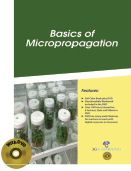Agriculture and Life Sciences

Just as every person is di erent and unique, so is each plant. Some have traits like better color, yield, or pest resistance. For years, scientists have looked for methods to allow them to make exact copies of these superior individuals. Plants usually reproduce by forming seeds through sexual reproduction. That is, egg cells in the owers are fertilized by pollen from the stamens of the plants. Each of these sexual cells contains genetic material in the form of DNA. During sexual reproduction, DNA from both parents is combined in new and unpredictable ways, creating unique organisms. This unpredictability is a problem for plant breeders as it can take several years of careful greenhouse work to breed a plant with desirable characteristics. Many of us think that all plants grow from seeds but now, researchers have developed several methods of growing exact copies of plants without seeds. Micropropagation is the growing of plants from meristematic tissue or somatic cells of superior plants on nutrient suitable media under controlled aseptic physical conditions. Micropropagation is used to multiply noble plants such as those that have been genetically modi ed or bred through conventional plant breeding methods. It is also used to provide a su cient number of plantlets for planting from a stock plant which does not produce seeds, or does not respond well to vegetative reproduction.